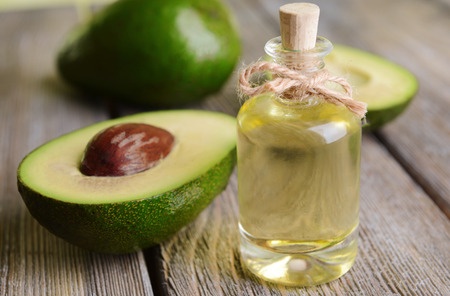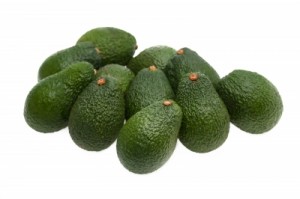
Avocado oil is one of the healthiest dietary oils available for the nutritionist and for culinary use. We explore some of its properties here. The avocado (Persea americana) is a subtropical tree found in Chile, the USA and Mexico, Indonesia, Spain, and Australasia. There have been significant developments in the production and marketing of avocado oil because of its cosmetic and nutritional value.

When fruit is rejected for the fresh market, the seed is also rejected whilst it is pulped to yield a highly valuable oil for both food and cosmetic use. Skin creams and hair detergents use it readily because it is absorbed by the skin and may even provide protection as a sun cream because of its unsaponifiable activity.
The crude oil needs to be refined, bleached and deodorised before use. Aqueous extraction produces a ‘naturally’ extracted culinary oil (Wong et al., 2008). In sensory terms, it has a buttery flavour but none of the bitterness and pungency associated with olive oil.
It is pale yellow retaining little of the odour. In shallow-pan frying, it has a high enough smoke point (225 – 250°C) to allow it to compete with extra virgin olive oil. The oil content is also similar to olive oil. The mature pulp is 10 to 32% w/w flesh but depends on harvesting time (Woolf et al., 2009). The seed contains little oil (ca. 2%) and is best used for composting. Cold-pressed oil contains 56-78% oleic acid, 10-20% palmitic acid, 4-9% palmitoleic acid, and 10-15% linoleic acids. Pigments are retained which make the oil green – 11-18.5% w/w chlorophylls and carotenoids 0.9-3.5 mg/kg carotenoids.
The health benefits are due to bioactives, mainly fats which are lipid-soluble. It contains 2-7% unsaponifiable lipids and monounsatured fats with 2230-4480 mg/kg pulp of total sterols (mainly β-sitosterol of 81-92% w/w), but also including brassicasterol, campesterol and avenasterol, 70 to 190 mg/kg tocopherols (vitamin E) with a mean value of 110 mg/kg α-tocopherol (Watson, 2009).
Functional Properties of Avocado Oil
Avocado oil, extracted from the flesh of the avocado fruit (Persea americana), is renowned for its functional properties which make it highly versatile in culinary, cosmetic, and industrial applications.
1. Physical Properties
- Viscosity: Avocado oil has a medium viscosity, making it an excellent carrier oil in cosmetic formulations and an ideal cooking oil.
- Color: It ranges from pale yellow to deep green, depending on the extraction method and the ripeness of the fruit.
- Odor: It has a mild, slightly nutty aroma, which can enhance the sensory profile of food products and personal care items.
2. Thermal Stability
- High Smoke Point: Avocado oil has a smoke point of around 480°F (250°C), one of the highest among plant oils. This makes it suitable for high-heat cooking methods like frying and sautéing without breaking down or producing harmful compounds.
3. Emulsifying Properties
- Emulsifier: Due to its balanced fatty acid profile, avocado oil can stabilize emulsions, which is valuable in the formulation of dressings, sauces, and mayonnaise. In cosmetics, it aids in the creation of stable emulsions for creams and lotions.
4. Oxidative Stability
- Resistance to Rancidity: Avocado oil’s high content of monounsaturated fats and natural antioxidants (like vitamin E) provides it with a good shelf life and resistance to oxidative rancidity. This stability is crucial for maintaining the quality of food products and cosmetics over time.
5. Texturizing Agent
- Creamy Texture: In both food and cosmetics, avocado oil contributes a smooth and creamy texture. It can enhance the mouthfeel of dressings and dips, and provide a luxurious feel in skin care products.
Extraction Methods of Avocado Oil
1. Cold Pressing:
- Process: The avocados are first de-pitted and mashed into a pulp. The pulp is then subjected to mechanical pressing at low temperatures to extract the oil.
- Advantages: This method preserves the oil’s natural flavors, colors, and nutrients, resulting in a high-quality, virgin avocado oil.
2. Centrifugation:
- Process: After mashing the avocado pulp, it is mixed with water and then spun at high speeds in a centrifuge. The centrifugal force separates the oil from the water and solids.
- Advantages: This method can be efficient and yield high-quality oil with minimal thermal degradation.
3. Solvent Extraction:
- Process: This involves using a solvent, typically hexane, to dissolve the oil from the avocado pulp. The oil-solvent mixture is then heated to evaporate the solvent, leaving behind the oil.
- Advantages: This method can extract a larger quantity of oil from the pulp but may result in the loss of some flavor and nutrients. It is also less preferred due to the potential for solvent residues.
4. Refining:
- Process: The extracted oil can be further refined to remove impurities, pigments, and odors. Refining involves steps like degumming, neutralization, bleaching, and deodorization.
- Advantages: Refined avocado oil has a more neutral flavor and higher smoke point, making it suitable for versatile culinary uses.
Use in Compound Coatings
1. Edible Coatings
- Function: Avocado oil can be used in edible coatings for fruits, vegetables, and other food products to extend shelf life, retain moisture, and enhance appearance.
- Properties: Its high oxidative stability and mild flavor make it an excellent choice for creating protective, edible films that do not impart unwanted tastes to the food.
2. Chocolate and Confectionery
- Application: In chocolate and confectionery, avocado oil can be used as a fat component in compound coatings. These coatings are often used as a cost-effective alternative to pure chocolate.
- Benefits: Avocado oil contributes to a smooth texture and good melting properties in compound coatings. Its stability helps in maintaining the quality of the coating during storage and consumption.
3. Pharmaceutical Coatings
- Use: Avocado oil can be incorporated into coatings for pharmaceutical tablets and capsules. These coatings can aid in the controlled release of active ingredients and protect the core from environmental factors.
- Advantages: The biocompatibility and non-toxicity of avocado oil make it suitable for use in medicinal applications.
Avocado Fat
Avocado fat is the stearin or hard fat variant of avocado oil when it has been fractionated. Greatest interest has been shown in it as a replacement for lard. Interestingly it too could function as a cocoa butter equivalent if the behaviour can be adjusted. It is a semi-solid substance with properties comparable to cocoa butter. It is semi-solid at room temperature. Various mixes have been tried with palm stearin and cocoa butter. Of all the fat mixtures, avocado fat:palm stearin:cocoa butter (84:7:9) displayed closest similarity to animal lard in performance (Noorzyanna et al., 2017).
Heart Health Benefits
Avocado oil contains a high concentration of a sterol known as beta-sitosterol, which converts less healthy fats into variants which are not so damaging to cells. A number of studies confirming its heart health benefits have been conducted in animals. For example, one rabbit study compared avocado oil to olive, corn and coconut oils. The avocado oil had similar beneficial effects to reducing blood cholesterol levels compared to the other oils (Kritchevsky et al., 2003).
Avocado oil offers strong anti-inflammatory properties too. It helps to prevent damage to arterial walls which in turn lowers the risk of heart disease caused by plaque formation and their deposition onto the arterial walls. Furthermore, less inflammation in the arteries means avocado oil can also go a long way toward keeping blood pressure at normal, healthy levels.
It is reported to inhibit growth of prostate cancer cells, reduce fat accumulation and obesity, protect eyesight in the elderly besides (Woolf et al., 2009; Lu et al., 2005; Koh et al., 2004).
Probable Reduction In Arthritis
Arthritis is a common disease especially in the elderly. The joints are affected by a painful inflammation. It is relatively common and affects virtually everyone. One particularly common form called osteoarthritis involves the destruction of cartilage. Cartilage helps the joints move together otherwise with ease. A number of studies with avocado oil and soybean oil together known as avocado/soybean unsaponifiables (ASU) could reduce pain, stiffness and ease joint mobility associated with this type of arthritis especially (Christiansen et al., 2015).
The oil now has prescription drug status in France because of clinical evidence surrounding its efficacy in reducing the impact of arthritis. Arthrocen is an ASU-containing supplement. Arthrocen’s avocado and soy unsaponifiables are extracted and sold in bulk form under the trade name AvoVida. It contains avocado and soy unsaponifiable extracts in a 1 : 2 ratio, respectively (Goudarzi et al., 2017).
Psoriasis
Inclusion of the oil in creams containing vitamin B12 have potential in treating chronic psoriasis (Stücker et al., 2001).
There are excellent reviews of the oil as well as the fruit itself which should be examined as it provides a very up to date assessment of the food (Dreher and Davenport, 2013; Ranade & Thiagarajan, 2015).
Nutrition facts: per 100 grams
| Calories | 884 kcal |
| % Daily Value* | |
| Total Fat 100g | 153 |
| Saturated fat 12g | 60 |
| Polyunsaturated fat 13g | |
| Monounsaturated fat 71g | |
| Sodium 0 mg | 0 |
| Total Carbohydrate 0 g | 0 |
| Dietary Fibre 0 g | |
| Protein 0 g | |
| Vitamin A 0% | Vitamin C 0% |
| Calcium 0% | Iron 0% |
| Vitamin B6 0% | Vitamin B12 0% |
| Magnesium 0% |
* The per cent daily values are based on a 2,000 calorie diet. The daily values may be higher or lower depending on your dietary needs.
Avocado oil stands out for its unique functional properties, making it a valuable ingredient across various industries. Its high smoke point and thermal stability make it ideal for culinary applications, while its emulsifying and texturizing properties benefit both food and cosmetic formulations. The oil’s oxidative stability ensures a long shelf life and maintains quality over time. The extraction methods, ranging from cold pressing to solvent extraction, influence the quality and application suitability of the oil. .
Products
Please note this post contains links to our affiliate marketing partner. Please read our affiliate marketing disclosure.
References
Lu, Q., Arteaga, J. R., Zhang, Q., Huerta, S., Go, V. L. W., & Heber, D. (2005) Inhibition of prostate cancer cell growth by an avocado extract: role of lipid-soluble bioactive substances. J. Nutr.Biochem., 16(1), pp. 23-30
Wong, M., O. Ashton, C. Requejo-Jackman, T. McGhie, A. White, L. Eyres, N. Sherpa, and A. Woolf. Avocado Oil: The Color of Quality. In ACS symposium series, vol. 983, pp. 328-349. Oxford University Press, 2008.
Woolf, A., Wong, M., Eyres, L., McGhie, T., Lund, C., Olsson, S., Wang, Y., Bulley, C., Wang, M., Friel, E., & Requejo-Jackman, C. (2009). Avocado oil. In R.A. Moreau, & A. Kamal-Eldin (Eds.), Gourmet and health-promoting specialty oils (pp. 73-125). Urbana: AOCS Monograph Series on Oilseeds


Leave a Reply